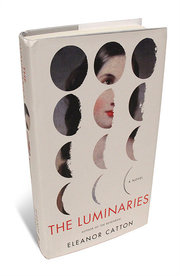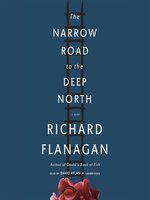The Man Booker Prize, awarded each year to the best English-language novel published by a company based in the United Kingdom, has now achieved a level of prestige comparable to the Pulitzer. By the terms described above, one might expect that most Booker winners would be as thoroughly British as a gaggle of Wodehousian aristocrats sitting down to roast, pudding, and port.
In reality, the Prize has been awarded to writers from around the world since its 1969 inception, and most recently, the last two prizes went to historical novels written by authors from Oceania: The Luminaries, by 28 year-old New Zealander Eleanor Catton (the youngest person to ever win), and The Narrow Road to the Deep North by 53 year-old Australian Richard Flanagan. The combination of a shared setting and two very different perspectives inspired me to pick up both works.
The Luminaries Takes You Fully Back in Time
 Eleanor Catton’s writing astounds me, for it so perfectly echoes the style of Eliot, Trollope, and other Victorian masters. The 830 pages of The Luminaries revel in omniscient third-person narration, deliciously elaborate word choices, and a plot complex enough to fill a book three times as long, boasting twenty characters and much time-jumping. Moreover, she recreates the era’s social attitudes, theatrically seedy underbelly, and sense of progress and possibility to the last detail, and she does it all with a remarkable mastery: from first page to last, she is firmly in control and makes sure all the pieces of the story perfectly fit.
Eleanor Catton’s writing astounds me, for it so perfectly echoes the style of Eliot, Trollope, and other Victorian masters. The 830 pages of The Luminaries revel in omniscient third-person narration, deliciously elaborate word choices, and a plot complex enough to fill a book three times as long, boasting twenty characters and much time-jumping. Moreover, she recreates the era’s social attitudes, theatrically seedy underbelly, and sense of progress and possibility to the last detail, and she does it all with a remarkable mastery: from first page to last, she is firmly in control and makes sure all the pieces of the story perfectly fit.
The novel opens with a 300+-page first chapter that is a true tour de force. Walter Moody, a young man striking out alone after major family drama, lands in New Zealand in 1866 in the midst of the country’s gold rush. He checks into a hotel and discovers twelve men in the public smoking room, all of whom seem anxious for him to leave…until they discover he might hold the missing piece in a mystery they’re trying to solve involving a corrupt politician, a greedy captain, a prostitute with much to hide, a missing prospector, and a dead hermit who somehow had a fortune.
 What makes this fascinating is the thirteen men in the smoking room are truly the supporting cast, the equivalent of the minor characters in War and Peace and Middlemarch who get some memorable traits and dialogue but play second fiddle to the protagonists. Catton puts them front and center by filtering the main dramatic action through their eyes—a move that better reflects reality, where not everyone gets to have a grand, eventful adventure but everyone does get to have a meaningful point of view. This, together with her diverse range of characters (a mix of British, Chinese, French, and Maori) and themes of sexual and economic politics, guarantees that for all its delightful old-fashionedness, The Luminaries is distinctly modern.
What makes this fascinating is the thirteen men in the smoking room are truly the supporting cast, the equivalent of the minor characters in War and Peace and Middlemarch who get some memorable traits and dialogue but play second fiddle to the protagonists. Catton puts them front and center by filtering the main dramatic action through their eyes—a move that better reflects reality, where not everyone gets to have a grand, eventful adventure but everyone does get to have a meaningful point of view. This, together with her diverse range of characters (a mix of British, Chinese, French, and Maori) and themes of sexual and economic politics, guarantees that for all its delightful old-fashionedness, The Luminaries is distinctly modern.
Hence, it is almost a disappointment when Catton ends the novel by leaping back seven months in time and telling the entire story again from the points of view of the heroes and villains, not the thirteen observers. She fills in the entire plot, but the repetition grows almost tiresome, and a key subplot involving her structuring device of the astrological chart (each character represents a sign or planet) is too supernatural and confusing for a realist narrative, but the storytelling and rich prose remain undiminished in their power.
The Narrow Road to the Deep North is a Shattering Masterpiece
Five hundred pages shorter than The Luminaries, Richard Flanagan’s novel spans a century of action, mostly during World War II, but somehow feels even more intimate and able to overpower the soul.
 I have read many novels of heartbreak, survival, and the simple act of living in the past, but few novels have ever used words to express the emotional sensations we feel as The Narrow Road to the Deep North. At times, such as in a death scene during the book’s longest chapter, the writing makes teeth chatter and forces the reader to close the cover for a while before continuing. Mostly, Flanagan’s writing fulfills George Orwell’s axiom that a good book tells you what you already know. On page after page, Flanagan would surprise me with some sentence I never saw coming and yet confirmed what my heart and experience had made me believe long before someone else found the way to write it down. As a statement of what can destroy and strengthen human beings and what we are capable of enduring, as a message affirming the universality of certain basic traits within us, The Narrow Road to the Deep North has few equals.
I have read many novels of heartbreak, survival, and the simple act of living in the past, but few novels have ever used words to express the emotional sensations we feel as The Narrow Road to the Deep North. At times, such as in a death scene during the book’s longest chapter, the writing makes teeth chatter and forces the reader to close the cover for a while before continuing. Mostly, Flanagan’s writing fulfills George Orwell’s axiom that a good book tells you what you already know. On page after page, Flanagan would surprise me with some sentence I never saw coming and yet confirmed what my heart and experience had made me believe long before someone else found the way to write it down. As a statement of what can destroy and strengthen human beings and what we are capable of enduring, as a message affirming the universality of certain basic traits within us, The Narrow Road to the Deep North has few equals.
My description of the novel thus far feels both hopelessly inadequate and merely the best I can do. It is hard to prosaically put down how Flanagan’s writing made me weep in the middle of my office cafeteria and impressed some of the most haunting imagery possible on my mind. He writes about violence, death, sex, and moments when adrenaline and will take over with such visceral poetry that one cannot help but be swept up in it, and I’d be afraid to meet a person unaffected by the novel.
 I would be remiss to note that The Narrow Road to the Deep North (which its takes its title from Basho—the book is full of haikus) has a thoroughly compelling plot to accompany the poetry and philosophy. Dorrigo Evans is a working-class, poetry-loving Australian who has risen to both a medical degree and an engagement to an heiress who absolutely adores him. Dorrigo then finds himself caught up in a passionate affair with his uncle’s restless, passionate, younger wife Amy, the first person he’s ever felt truly in love with, only to have the affair cut off when he is sent off with the medical corps in World War II. Captured by the Japanese, his unit is put on a suicide mission to build a railroad across Burma under the command of Major Nakamura, a proud officer dealing with his own demons. The experience turns Dorrigo into a war hero, but for decades after he deals with guilt, sorrow, and a deep-seated feeling that he’s not fully aware of all that has transpired…a feeling confirmed on the heartbreaking final page.
I would be remiss to note that The Narrow Road to the Deep North (which its takes its title from Basho—the book is full of haikus) has a thoroughly compelling plot to accompany the poetry and philosophy. Dorrigo Evans is a working-class, poetry-loving Australian who has risen to both a medical degree and an engagement to an heiress who absolutely adores him. Dorrigo then finds himself caught up in a passionate affair with his uncle’s restless, passionate, younger wife Amy, the first person he’s ever felt truly in love with, only to have the affair cut off when he is sent off with the medical corps in World War II. Captured by the Japanese, his unit is put on a suicide mission to build a railroad across Burma under the command of Major Nakamura, a proud officer dealing with his own demons. The experience turns Dorrigo into a war hero, but for decades after he deals with guilt, sorrow, and a deep-seated feeling that he’s not fully aware of all that has transpired…a feeling confirmed on the heartbreaking final page.
The story is exciting, suspenseful, and romantic, the characters are written with great psychological depth and a sense of universal empathy, and the set pieces, ranging from grand-scale confrontations in the Pacific Theatre to a destructive wildfire in postwar Australia to a raucous dinner at a fried fish shop (one of the few surprisingly joyous moments) are more than memorable. One could read The Narrow Road to the Deep North for the surface qualities alone. One could, and should, be transformed by what’s below the surface.
Photographs from unshredded.net, bespectacledme.com, Entertainment Weekly, The Independent, and The Wall Street Journal





